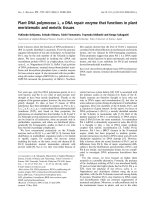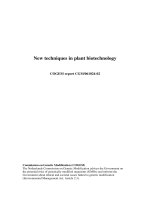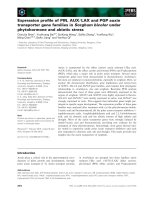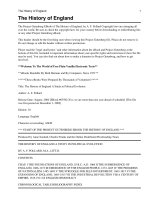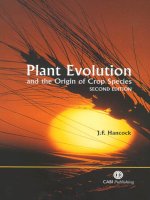NDH expression marks major transitions in plant evolution and reveals coordinate intracellular gene loss
Bạn đang xem bản rút gọn của tài liệu. Xem và tải ngay bản đầy đủ của tài liệu tại đây (907.54 KB, 9 trang )
Ruhlman et al. BMC Plant Biology (2015) 15:100
DOI 10.1186/s12870-015-0484-7
RESEARCH ARTICLE
Open Access
NDH expression marks major transitions in plant
evolution and reveals coordinate intracellular
gene loss
Tracey A Ruhlman1†, Wan-Jung Chang2†, Jeremy JW Chen3†, Yao-Ting Huang4†, Ming-Tsair Chan2†, Jin Zhang1,
De-Chih Liao2, John C Blazier1, Xiaohua Jin5, Ming-Che Shih2, Robert K Jansen1,6 and Choun-Sea Lin2*
Abstract
Background: Key innovations have facilitated novel niche utilization, such as the movement of the algal
predecessors of land plants into terrestrial habitats where drastic fluctuations in light intensity, ultraviolet radiation
and water limitation required a number of adaptations. The NDH (NADH dehydrogenase-like) complex of Viridiplantae
plastids participates in adapting the photosynthetic response to environmental stress, suggesting its involvement in the
transition to terrestrial habitats. Although relatively rare, the loss or pseudogenization of plastid NDH genes is widely
distributed across diverse lineages of photoautotrophic seed plants and mutants/transgenics lacking NDH function
demonstrate little difference from wild type under non-stressed conditions. This study analyzes large transcriptomic
and genomic datasets to evaluate the persistence and loss of NDH expression across plants.
Results: Nuclear expression profiles showed accretion of the NDH gene complement at key transitions in land plant
evolution, such as the transition to land and at the base of the angiosperm lineage. While detection of transcripts
for a selection of non-NDH, photosynthesis related proteins was independent of the state of NDH, coordinate,
lineage-specific loss of plastid NDH genes and expression of nuclear-encoded NDH subunits was documented in
Pinaceae, gnetophytes, Orchidaceae and Geraniales confirming the independent and complete loss of NDH in
these diverse seed plant taxa.
Conclusion: The broad phylogenetic distribution of NDH loss and the subtle phenotypes of mutants suggest
that the NDH complex is of limited biological significance in contemporary plants. While NDH activity appears
dispensable under favorable conditions, there were likely sufficiently frequent episodes of abiotic stress affecting
terrestrial habitats to allow the retention of NDH activity. These findings reveal genetic factors influencing
plant/environment interactions in a changing climate through 450 million years of land plant evolution.
Keywords: Streptophyta, NAD(P)H dehydrogenase, Transcriptomics, Cyclic electron flow, Sig4
Background
Key innovations have facilitated novel niche utilization,
such as the movement of the algal predecessors of land
plants into terrestrial habitats [1] where fluctuations in
light intensity, ultraviolet radiation and water limitation
required a number of adaptations [1,2]. Among them,
mechanisms that permitted more refined control of the
* Correspondence:
†
Equal contributors
2
Agricultural Biotechnology Research Center of Academia Sinica, Agricultural
Technology Building, No. 128, Sec. 2, Academia Road, Nankang, Taipei 115,
Taiwan
Full list of author information is available at the end of the article
light reactions of photosynthesis may have evolved. The
NDH (NADH dehydrogenase-like) complex of plant and
algal plastids, which participates in cyclic electron flow
(CEF), was initially identified through its homology to
the mitochondrial respiratory complex I [3], then shown
to be more similar to the NDH-1 pathway of extant
cyanobacteria [4,5].
During the light reactions of photosynthesis in cyanobacteria, algae and plants, photons excite pigment/
chlorophyll molecules in photosystem II (PSII) at the
stromal face of the chloroplast thylakoid membrane. This
light energy, in the form of water derived electrons, is
© 2015 Ruhlman et al.; licensee BioMed Central. This is an Open Access article distributed under the terms of the Creative
Commons Attribution License ( which permits unrestricted use, distribution, and
reproduction in any medium, provided the original work is properly credited. The Creative Commons Public Domain
Dedication waiver ( applies to the data made available in this article,
unless otherwise stated.
Ruhlman et al. BMC Plant Biology (2015) 15:100
ultimately relayed to photosystem I (PSI) via the intermediate carriers of the electron transport chain to drive
proton translocation across the membrane and into the
thylakoid lumen. The resulting proton gradient is coupled
to ATP synthesis via ATP Synthase with the concomitant
reduction of NADP to yield NADPH by ferredoxin-NADP
reductase. This process is referred to as linear electron
flow and/or transport (LEF). While LEF is the primary
pathway for conversion of photons into storable energy,
CEF occurs exclusively around photosystem I and contributes to generation of the proton gradient. However the
electrons that reduce the plastoquinone (PQ) in CEF are
recycled directly from ferredoxin (Fd) allowing for the
generation of ATP without the production of NADPH.
The resulting high pH differential across the thylakoid
membrane induces non-photochemical quenching (NPQ)
allowing the dissipation of excess electrons under potentially unfavorable growth conditions including fluctuating,
high intensity light, low CO2 concentration or drought
stress [6,7].
Two independent pathways of CEF have been characterized across Streptophyta, the lineage that includes
charophyte algae and land plants [6,8]. The genomes of
extant cyanobacteria encode the core components of the
NDH complex and a pathway for CEF that is sensitive to
antimycin A (AA) [9] as has been elucidated in land
plants [6]. Sequencing of the Klebsormidium flaccidum
genome, a streptophyte alga, revealed genes encoding
both a functional NDH, with subunit genes in the plastid
and nuclear genomes, and components of the nuclear
encoded PGR5-dependent (Proton Gradient Regulation5;
AA sensitive) pathway of CEF [1].
While both pathways clearly originated in the ancestor
of plastids, and both rely on Fd-dependent reduction of
PQ, the PGR5-dependent pathway is the main contributor
to the pH differential and ultimately ATP generation in
CEF [6]. This may be the reason for its ubiquity among
the photosynthetic organisms studied to date, whereas
NDH CEF has been lost in all photosynthetic lineages examined other than Streptophyta [1,8]. The two pathways
are encoded by non-overlapping gene sets and are
therefore predictably mechanistically distinct [10].
Cyclic electron flow is essential to efficient photosynthesis and complete inhibition of CEF severely affects LEF in vivo [10]; however, the specific role of
NDH in CEF remains obscure. Studies support NDH
involvement in redox balancing under abiotic stress as
it appears to mediate electron flow from stromal reductants to PQ [11-13]. Phenotypes, such as photoinhibition, reduced growth rate and the loss of NPQ
induction, are severe where both CEF pathways are restricted [10-14], pronounced when the PGR5-dependent
pathway is impaired and subtle when only NDH expression is ablated [5,10,15].
Page 2 of 9
Under favorable growth conditions disruption of NDH
has little effect. However CO2 limitation, extended exposure to low temperatures and high or low light intensities
revealed mildly deleterious phenotypes. Oryza sativa crr6
(required for NDH complex biogenesis) mutants lacked
the post illumination increase in chlorophyll fluorescence
that is a hallmark of Fd-dependent PQ reduction, and exhibited mild inhibition of all photosynthetic parameters
measured and a diminution in plant biomass when grown
at 20°C [16]. The disruption of plastid ndhB in Marchantia
polymorpha resulted in a PQ pool that was significantly
more reduced at low light intensities relative to the wild
type [12]. Nicotiana tabacum inactivated for plastid
encoded NDH-B showed a reduction in transient chlorophyll fluorescence following actinic illumination, but otherwise performed normally [5]. Repeated, brief exposure to
strong light, however, resulted in photoinhibition of PSII
and irreversible chlorosis in the same transformed line
whereas wild type leaves exposed to the same treatments
recovered [13].
Like many plastid-localized, multi-subunit complexes,
both plastid- and nuclear-encoded proteins assemble to
form the NDH complex [17]. Although relatively rare, the
loss or pseudogenization of plastid NDH genes is nonetheless noted across diverse lineages of photoautotrophic seed
plants with examples found among gymnosperms [18,19],
and both monocot [20-24] and eudicot lineages of angiosperms [25]. As in the preceding experimental examples,
these species appear unaffected by the lack of plastid
NDH gene expression and several authors have suggested
that the missing NDH constituents may have been functionally transferred to the nucleus [18-22,25,26].
Based on phenotypes of mutants/transgenics, NDH function appears to be dispensable under favorable growth conditions; however, the plastid-encoded genes for NDH
subunits are conserved across the phylogeny of Streptophyta suggesting a strong selective advantage in retention of
NDH function [1]. This study uses large-scale transcriptomic and genomic analyses to evaluate the persistence and
loss of NDH expression. Nuclear expression profiles showed
that there have been acquisitions of novel NDH genes at
key transitions throughout 450 million years of land plant
evolution. In the clades where the NDH genes are missing
from the plastid genome, no evidence of intracellular horizontal gene transfer of NDH genes was detected. Rather coordinate, lineage-specific loss of expression of nuclearencoded NDH subunits confirmed the independent loss of
NDH in select taxa across the seed plant phylogeny.
Results and discussion
To evaluate the distribution and timing of changes in the
NDH gene complement across land plants a subject database comprising nuclear transcriptomes of photoautotrophic Streptophyta species (listed in Additional file 1) was
Ruhlman et al. BMC Plant Biology (2015) 15:100
Page 3 of 9
queried with Arabidopsis NDH-related coding sequences
and the results of the survey mapped in a phylogenetic
context. Queries included constituents of each of the four
major subunits containing nuclear proteins, the Lhca
(light harvesting complex associated) proteins involved in
tethering NDH to PSI during supercomplex formation, assembly and accessory proteins, ndhF transcription factor
Sig4 and proteins involved in maturation and editing of
NDH transcripts in plastids (see Additional file 1 for a
complete list). The core constituents of NDH are encoded
by genes derived from the common cyanobacterial ancestor of all photosynthetic eukaryotes, 11 genes encoded in
the plastid (ndhA-K) and five in the nucleus (ndhL-S) [17].
Additional related sequences (subunits and auxiliary
proteins) were acquired through time and demonstrate
an accretion in complexity within NDH, notably at the
split between the chlorophyte algae and streptophytes,
between charophytes and terrestrial plants, at the origin
of seed plants and the base of angiosperms (Figure 1).
The more recent gene acquisitions portray an increasing requirement for coordinated control of plastid-encoded gene
expression. The majority of gains occurred prior to the diversification of angiosperms and include ndhF transcription
factor Sig4, and PPR proteins involved in processing of
plastid NDH polycistrons and RNA editing (Figure 1;
Additional file 1). The co-emergence of Lhca6 at the
base of angiosperms could be related to the apparent
requirement for tightly controlled expression of subunits. Supercomplex formation with PSI is thought to
positively influence stability of NDH in flowering
plants, although a role in NDH assembly has not been
discounted [27]. Nuclear control of plastid gene expression may be a means to regulate the stoichiometry of
PSI:NDH subunits for optimal efficiency. Whole genome
duplication, which occurred in virtually all angiosperms
[28], may have been important in generating nuclear substrate sequences for sub- or neo-functionalization yielding
the more complex NDH system. Greater control and efficiency of the CEF system, among many other innovations
(i.e. [29-31]), may have played a role in the eventual angiosperm radiation into virtually every terrestrial ecosystem.
Despite near ubiquity, a number of exceptional cases
exist among photosynthetic species where the NDH
genes have been pseudogenized or are entirely missing
from plastid genomes (Figure 2A). Among plastomes of
Viridiplantae, the loss of NDH genes has been reported
for all species of Gnetophyta and Pinaceae, several species in the Orchidaceae and in the long-branch clade
within the genus Erodium (Geraniaceae). It appears that
another species in the Geraniales, Melianthus villosus, is
undergoing NDH loss as four of its plastome-encoded
NDH genes are pseudogenes [32]. Plastid NDH gene loss
was recently revealed in the monocot family Hydrocharitaceae, which harbors at least three species of aquatic
seeds
vascular
Pteridophyta
CRR3
Lycopodiophyta
Anthocerophyta
Bryophyta
Marchantiophyta
terrestrial
NDF5, PnsB2
PnsL5, CRR41
NdhU, Lhca5
NdhT, PnsB1, PnsB3, PnsB5
Gymnospermae
streptophytes
Angiospermae
Zygnematophyceae
Colechaetophyceae
Klebsormidiophyceae
Mesostigmatophyceae
Chlorokybophyceae
charophytes
PnsL1
PnsL4
flowers
PnsL2, PnsL3, PQL3, Lhca6, CRR2, CRR4, CRR21, Sig4
Chlorophyta
Figure 1 Accretion of NDH complexity through streptophyte evolution. Plotted at the nodes are novel genes that have no known homologue in
extant cyanobacteria. Gene acquisitions were placed at the node to indicate first appearance regardless of putative, subsequent losses. Note that the
PnsB3 transcript was detected in one species among the three Chlorophyta included (Additional file 1).
Ruhlman et al. BMC Plant Biology (2015) 15:100
Page 4 of 9
Figure 2 Distribution and timing of plastid and nuclear NDH gene loss across seed plants. Representation of land plant relationships (A). Groups
where photosynthetic taxa have lost/pseudogenized plastome NDH genes are indicated with red font; arrows indicate the relevant cladogram for
each subgroup. (B-D) Cladograms showing divergence times and lineage specific loss of nuclear transcripts encoding NDH proteins. ‘A, lumenal
and B’ refer to subunits in the NDH complex. Green shading indicates detection of the nuclear transcript for each gene. Numeric values indicate
the divergence time (MYA: million year ago) for each lineage. In C, the asterisk indicates a questionable branch discussed in the text. In D, the
number after the generic name indicates the number of species included in the analysis with identical patterns with regard to NDH expression.
Orchid and Geraniales relationships are represented by plastid 12-gene maximum likelihood trees (see Methods); gymnosperm phylogeny is
based on two plastid genes, rbcL and matK.
angiosperms that have undergone NDH disruption (Najas
Vallisneria, Thalassia) with two further losses likely
among the marine ‘seagrasses’ in the order Alismatales
(Posidonia, Amphibolis) [23,24].
Of the non-NDH plastome genes that have been lost
or pseudogenized, several have been detected in the nuclear genome where their expression is regulated by nuclear factors and subsequent products targeted back to
plastids. Although several groups have suggested that
plastid NDH pseudogenes may be functionally represented by nuclear sequences [18-22,25], no reports describe a functionally transferred, nuclear NDH gene of
recent plastid origin. A number of nuclear-encoded
NDH subunits and accessory proteins have been elucidated [6,8], which are targeted to the plastid where they
assemble with plastome-encoded subunits at the thylakoid membrane. Figures 2B-D present an abbreviated
graphical overview of the pattern of NDH nuclear gene
loss. In all investigated lineages where the plastid sequences have been lost, no transcripts were detected
that could represent recently transferred plastid NDH
genes. Furthermore, transcripts reporting expression of
nuclear-encoded NDH subunits are, to varying degrees,
absent (Figure 2B-D, Additional file 1). To confirm that
the lack of nuclear NDH transcripts is exclusive to NDH
genes and not a more general phenomenon and to demonstrate that there were sufficient data to detect such
transcripts were they present, transcriptomes of plastid
NDH-deleted species and those that retain NDH in the
plastome were queried for the presence of transcripts
Ruhlman et al. BMC Plant Biology (2015) 15:100
encoding members of gene families to which NDH subunits belong. Regardless of the state of the NDH system
nearly all searched non-NDH transcripts inherent to
photosynthesis and plastid respiration were detected
(Additional file 2). In a very few cases where data were
mined from public databases, expected transcripts (i.e.
PGR5) were not detected. Overall the mined data yielded
findings highly similar to those found using the data
produced for this study, the collection of which was
standardized according to Zhang et al. [33]. The downloaded transcriptomes varied broadly in terms of tissue
type, library construction, sequence length and read
depth, however they were of sufficiently high quality to
detect most if not all genes searched for this study. The
use of Arabidopsis reference sequences may have also
allowed some transcripts to go undetected due to high
levels of divergence between the reference and the taxa
examined.
Indeed, the ‘patchy’ signal detected for lhca5 (Additional
file 1) prior to its consistent presence in angiosperms
could be a result of the caveats described above. For this
study the parameters used to define a transcript as present
or absent, as described in the methods, were set a priori,
as was the decision to report the first incidence of detection regardless of subsequent lack of detection in more
recently diverged lineages. The chlorophyte algae Clamydomonas reinhardii and Ostreococcus tauri, among
others, are thought to contain a gene encoding Lhca5
(GenBank, ABD37907 and AAY27547.1), however the
transcript was not detected using the present data mining strategy. Of course these species are known to lack
NDH and likely their lhca5 sequences are not similar
enough to be detected using Arabidopsis queries. Even
in more closely related groups, i.e. gymnosperms and
angiosperms, there is a margin for error although calls
of presence or absence are expected to be more reliable
between more recently diverged groups. The lhca5
transcript was detected in seven of 11 gymnosperm species that are competent for NDH CEF (Additional file 1).
The presence of the AA-sensitive pathway described
by Arnon et al. [34], the predominant pathway for CEF
in plants, was inferred by the identification of nuclear
transcripts encoding PGR5 and PGRL1 (A/B) in nearly
all species surveyed (Figure 2B-D; Additional file 1). Although wholesale loss of nuclear-encoded NDH gene expression is typical of the taxa in which plastome NDH
genes are absent, there is some variation across this select group. One ancestral NDH subcomplex A gene that
is retained across the majority of taxa except gnetophytes is the nuclear gene encoding NdhS (Crr31), responsible for high affinity binding of ferredoxin [11]
(Figure 2; Additional file 1). In experiments where this
function is ablated, NDH complex formation is concomitantly lost. However NdhS accumulated in the
Page 5 of 9
thylakoid membranes of mutants that do not express
NDH suggesting this protein may have an additional
function in plastids [11].
The gene encoding the thylakoid immunophilin PnsL5
(CYP20-2) lacks a cyanobacterial homolog and is nearly
ubiquitous across the species surveyed, apparently arising at the node leading to Zygnematophycaeae, the proposed sister lineage to land plants (Figure 1, Additional
file 1). Although PnsL5 has been identified in NDH and
NDH-PSI [35] preparations as a lumenal subcomplex
protein and its expression was strongly reduced in NDH
mutants with defects in the hydrophobic domains, mutants lacking PnsL5 expression were not affected in
complex stability or NDH activity [36]. There remains
some question regarding its status as a bona fide subunit
of NDH; while PnsL5/CYP20-2 may indeed be an NDHassociated protein this isomerase has demonstrated roles
in gibberillic acid and brassinosteroid signaling in Triticum and Arabidopsis, respectively [37,38]. Given that phytohormone signaling has been proposed as an adaptation
facilitating colonization of land by plants [30,39], the
emergence of PnsL5/CYP20-2 in the sister lineage to land
plants, tempts speculation of a dual role for this protein in
the early adaptation to land.
A phylogenetic context permits evaluation of the distribution of retention/loss as a function of evolutionary
time and thus the estimation of the number of independent losses that have occurred. For example within
gymnosperms there are two distinct groups lacking plastid NDH genes; all sampled gnetophytes and Pinaceae.
There has been considerable controversy regarding the
phylogenetic position of gnetophytes among gymnosperms
with several different placements supported by different
data sets (i.e. gnepine, gnetifer, anthopyte, gnetophytes sister to all other gymnosperms) [40-45]. Accordingly, interpretation of the pattern of NDH gene loss will be affected
by which of these hypotheses is correct. The tree shown in
Figure 2B is based on limited taxon sampling and two plastid genes, rbcL and matK, and reflects the relationships
identified in Lee et al. [46], placing gnetophytes as sister to
all other gymnosperms. The complete excision of all plastid NDH genes in Gnetum and Ephedra and a single detectable pseudogene in Welswitchia [47,48] suggest that
the loss in Pinaceae may be more recent as these plastomes
retain many more NDH pseudogenes [18]. If indeed the
relationships inferred by Lee et al. are correct, then two
independent losses would be appropriately assigned. Alternatively, if gnetophytes are sister to Pinaceae, then the
most parsimonious interpretation is of a single loss. Nonetheless, these events are relatively ancient (Figure 2B) and
both groups have similarly lost function of all plastid genes
for NDH along with nuclear NDH gene expression with
the exception of PnsL5 and, at least for the Pinaceae species, ndhS (Additional file 1). As seen in Orchidaceae,
Ruhlman et al. BMC Plant Biology (2015) 15:100
however, events interpreted as synapomorphic may in fact
represent independent events whose signals have been obscured through evolutionary time. This phenomenon is
well illustrated by the repeated, independent loss of the
plastome infA and accD genes among others [49].
Among the Orchidaceae four independent losses of
NDH are indicated (Figure 2C). However the 12-gene
phylogeny presented here is limited to the 11 species for
which both plastome and transcriptome data are available
and differs somewhat in topology from trees incorporating
hundreds of species. Expanded phylogenies have placed
Masdevallia outside the clade of higher epidendroids that
it groups with here [50]. This alternative placement
predicts three independent NDH losses among orchids.
Contrary to the suggestion that Sig4 evolved after the
diversification of eudicots [51], sig4 transcripts were detected among the orchid species that retain NDH function
as well as in Amborella (Additional file 1).
Recent loss of plastid NDH genes is observed in the
long- branch clade (LBC) of Erodium. Losses have been
confirmed in three among 13 species through complete
plastome sequencing; losses in all remaining species
were inferred through PCR survey for the ndhD gene
[25] suggesting that the loss occurred prior to the diversification of the clade (3 MYA). Within the Geraniales
there appears to be an even more recent loss in the
genus Melianthus where four NDH pseudogenes have
been identified in the plastome [32]. This clade is believed
to have diversified approximately 2 MYA and retains some
apparently translatable plastome NDH sequences. Probing
the M. villosus transcriptome revealed that while most
NDH related transcripts were detected, the ndhF transcription factor Sig4 is transcribed as a pseudogene
(Figure 2D).
Conclusions
These data allow insight into the distribution and timing
of NDH gene loss across seed plants and suggest at least
limited dispensability of NDH function. In no case were
functional nuclear copies of plastome NDH sequences
identified but rather the degradation and loss of nuclearencoded interacting proteins was revealed. The broad
phylogenetic distribution of NDH loss and the subtle
phenotypes of mutants suggest a high propensity for
gene loss and may be indicative of its limited biological
significance in contemporary plants [52]. On an evolutionary time scale, however, climate fluctuates in virtually all
habitats such that NDH function may be intermittently
significant. While NDH activity appears dispensable
under favorable conditions there may be sufficiently
frequent episodes of abiotic stress affecting terrestrial
habitats to allow the retention of NDH activity throughout
land plant evolution. In fact, the accumulation of RNA
editing sites in plastid NDH genes has been interpreted as
Page 6 of 9
arising from such recurrent “dispensability and rescue” of
NDH activity [8].
The timing of changes in the NDH gene complement
supports the hypothesis that the NDH system, among
other adaptations, has been involved in the transition to
terrestrial habitats and possibly other key innovations
throughout 450 million years of land plant evolution.
Given the present outlook on climate change a deeper
understanding of the genetic factors influencing the
adaptation of land plants to novel conditions will inform
management programs.
Methods
Plant materials
Tissue samples for species of Geraniales were harvested
from the living collection at University of Texas at Austin.
All specimens have been vouchered and deposited in the
UT Plant Resources Center (TEX-LL). Voucher numbers
are listed in Additional file 3.
Apostasia odorata was collected from Yunnan, China.
Cypripedium formosanum was obtained from highland
experimental farm, National Taiwan University in Meifeng, Taiwan. Three commercial Orchidaceae species
were purchased from a local grower in Taiwan, two Epidendroideae (Masdevallia picturata and Erycina pusilla)
and one Orchidoideae (Goodyera fumata). These three
species were grown in the greenhouses at Academia
Sinica, Taipei, and National Chung Hsing University,
Taichung, Taiwan.
RNA isolation, transcriptome sequencing and assembly
Total RNA from newly emerged leaves of 26 species in
Geraniales and four tissues (emergent and expanded
leaves, roots and flowers) of Pelargonium x hortorum
was isolated and cDNA libraries constructed following
the protocols described in Zhang et al. [33]. Transcriptome sequencing was performed on the Illumina HiSeq™
2000 platform (Illumina, San Diego, CA). For Orchidaceae, total RNA was extracted from young leaves by
TRIzol® reagent (Life-Technologies, Taipei City, Taiwan).
Agilent 2100 Bioanalyzer (Agilent Technologies, Taipei
City, Taiwan) was used to confirm total RNA quality. Six
paired-end RNA-Seq libraries (A. odorata, C. formosanum,
M. picturata, G. fumata, E. pusilla and H. longidenticulata) were constructed using the Illumina TruSeq™
Stranded mRNA HT, insert size was 300 bp. The libraries
were sequenced on Illumina NextSeq™ 500 paired-end
system using a NextSeq™ 500 Mid output kit (300 cycles;
Illumina). Sequence data of Geraniales and the five species
of orchid were preprocessed and assembled as described
in Zhang et al. [33]. Transcriptome data for the remaining
species examined were downloaded from the NCBI Sequence Read Archive (SRA, Additional file 1). Reads were
assembled with Trinity release 2013/11/10 (http://
Ruhlman et al. BMC Plant Biology (2015) 15:100
sourceforge.net/projects/trinityrnaseq/) using the parameters “–JM 100G –full_cleanup –min_contig_length 200
–CPU 24” on a 24-core 3.33 GHz linux work station with 1
TB memory at the Texas Advanced Computing Center
(TACC, />
Identification of nuclear-encoded ndh genes
The protein sequences of reference genes of Arabidopsis
were downloaded from TAIR [53]; accession numbers
are given in Additional files 1 and 2. Reference gene
sequences were aligned to the transcriptome assemblies using TBLASTN with e-value 1e-5 to extract the
nuclear encoded candidate genes of the NDH complex (See Additional file 4). The candidate genes were
then aligned to the Arabidopsis transcriptome using
BLASTX with default settings, and the gene was considered present if the top hit was the corresponding reference gene. If the top hit was not the corresponding gene,
manual inspection of these candidate genes was performed to resolve potential chimeric assembly problems
and the candidate genes were confirmed again with
BLASTX. All newly generated sequences have been
submitted to NCBI GenBank, accession numbers are in
Additional file 4.
Phylogeny construction
The phylogenies of 11 species of orchids plus Acorus and
26 species of Geraniales plus Arabidopsis were generated
by RAxML with parameters “raxmlHPC-PTHREADSSSE3 -f a -x 12345 -p 12345 -T 12 -m GTRGAMMAI -N
100” using 12 plastid genes (atpA, atpB, atpI, ccsA, cemA,
matK, petA, rbcL, rpoB, rpoC1, rpoC2, rps2), and bootstrap values were generated using RAxML with 100 replicates and the above settings. The gymnosperm phylogeny
of 11 species plus Psilotum was generated by the same parameters except that two sequences, matK and rbcL were
employed. For Figure 1 and 2A, trees were drawn manually based on relationships depicted in [54] and [45,46].
Divergence time estimation
Divergence time estimates were derived from previous
studies of gymnosperms [55,56], Orchidaceae [50] and
Geraniales [57,58].
Page 7 of 9
Additional files
Additional file 1: Expanded survey of nuclear encoded NDH
transcripts. This table includes data for 106 species, both generated in
this study and downloaded from a number of sources.
Additional file 2: Detection psbP, psbQ, lhca, FKBP and PGR gene
family transcripts in gymnosperms, Orchidaceae and Geraniales.
This table includes data for 50 species as indicated in the title and
reports the expression of nuclear genes unrelated to NDH.
Additional file 3: Voucher information for 26 species of Geraniales.
University of Texas Plant Resources Center voucher numbers for
Geraniales specimens used in this study.
Additional file 4: Accession numbers for all specific transcript
sequences generated in this study. Collection of GenBank accession
numbers for all new plastid genome and individual nuclear transcript
sequences reported in this study.
Abbreviations
LEF: Linear electron flow; CEF: Cyclic electron flow; PSI: Photosystem I;
PSII: Photosystem II; AA: Antimycin A; NDH: Plastid NAD(P)H dehydrogenaselike complex; MYA: Million years ago; Lhca: Light harvesting complex
genes/proteins; LBC: Long branch clade (as in Erodium).
Competing interests
The authors declare that they have no competing interests.
Authors’ contributions
TAR prepared RNA samples for Geraniales, designed analyses, assisted in
figure and table production and wrote the manuscript. WJC, JJWC, YTH, MTC
and CSL performed orchid sequencing, assembly and annotation, and
performed Blast searches of public sequences for genes of interest. WJC, DCL
and CSL contributed to figure and table production. DCL, XJ and MCS
isolated orchid RNA. DCL participated in orchid bioinformatics analyses. JZ
assembled and annotated transcriptomes for all Geraniales and several
orchids, and generated phylogenies for Figures 2B-D. RKJ designed analyses,
assisted in figure and table production. JCB provided sequences for 12-gene
phylogenies (Figure 1D). CSL developed initial experimental strategy and
designed analyses. All authors read and approved the final manuscript.
Acknowledgements
Support was provided by the National Science Foundation (IOS-1027259 to
RJK and TAR) and by Innovative Translational Agricultural Research
Administrative Office (to CSL). The authors thank Der-Ming Yeh, Li-Ya Chao
and Jin-Jue Yue for providing orchid materials and analysis, Robin Parer at
www.geraniaceae.com for Geraniaceae materials, and Don Levin, Tom
Juenger, Mike Ryan and two anonymous reviewers for comments on an
earlier version of the manuscript.
Author details
1
Department of Integrative Biology, University of Texas at Austin, Austin, TX,
USA. 2Agricultural Biotechnology Research Center of Academia Sinica,
Agricultural Technology Building, No. 128, Sec. 2, Academia Road, Nankang,
Taipei 115, Taiwan. 3Institute of Biomedical Sciences, National Chung Hsing
University, Taichung, Taiwan. 4Department of Computer Science and
Information Engineering, National Chung Cheng University, Chia-Yi, Taiwan.
5
Institute of Botany, Chinese Academy of Sciences, Beijing 100093, China.
6
Department of Biological Science, Biotechnology Research Group, King
Abdulaziz University, Jeddah 21589, Saudi Arabia.
Received: 1 December 2014 Accepted: 30 March 2015
Availability of supporting data
Phylogenetic datasets are available in Dryad Digital Repository ( Sequence
data are available in the Short Read Archive at GenBank,
accession numbers are
listed in Additional files 1, 2, 4.
References
1. Hori K, Maruyama F, Fujisawa T, Togashi T, Yamamoto N, Seo M, et al.
Klebsormidium flaccidum genome reveals primary factors for plant terrestrial
adaptation. Nat Commun. 2014;5:3978.
2. Rensing SA, Lang D, Zimmer AD, Terry A, Salamov A, Shapiro H, et al. The
Physcomitrella genome reveals evolutionary insights into the conquest of
land by plants. Science. 2008;319:64–9.
Ruhlman et al. BMC Plant Biology (2015) 15:100
3.
4.
5.
6.
7.
8.
9.
10.
11.
12.
13.
14.
15.
16.
17.
18.
19.
20.
21.
22.
23.
Matsubayashi T, Wakasugi T, Shinozaki K, Yamaguchi-Shinozaki K, Zaita N,
Hidaka T, et al. Six chloroplast genes (ndhA-F) homologous to human
mitochondrial genes encoding components of the respiratory chain NADH
dehydrogenase are actively expressed: determination of the splice sites in
ndhA and ndhB pre-mRNAs. Mol Gen Genet. 1987;210:385–93.
Friedrich T, Steinmüller K, Weiss H. The proton-pumping respiratory complex
I of bacteria and mitochondria and its homologue in chloroplasts. FEBS Lett.
1995;367:107–11.
Shikanai T, Endo T, Hashimoto T, Yamada Y, Asada K, Yokota A. Directed
disruption of the tobacco ndhB gene impairs cyclic electron flow around
photosystem I. Proc Natl Acad Sci U S A. 1998;95:9705–9.
Shikanai T. Central role of cyclic electron transport around photosystem I in
the regulation of photosynthesis. Curr Opin Biotechnol. 2014;26:25–30.
Buchanan B, Gruissem W, Jones R. Biochemistry & Molecular Biology of
Plants. Hoboken, NJ USA: Wiley; 2015.
Martín M, Sabater B. Plastid ndh genes in plant evolution. Plant Physiol
Biochem. 2010;48:636–45.
Yeremenko N, Jeanjean R, Prommeenate P, Krasikov V, Nixon PJ, Vermaas
WFJ, et al. Open reading frame ssr2016 is required for antimycin A-sensitive
photosystem I-driven cyclic electron flow in the cyanobacterium Synechocystis
sp. PCC 6803. Plant Cell Physiol. 2005;46:1433–6.
Munekage Y, Hashimoto M, Miyake C, Tomizawa K-I, Endo T, Tasaka M, et al.
Cyclic electron flow around photosystem I is essential for photosynthesis.
Nature. 2004;429:579–82.
Yamamoto H, Peng L, Fukao Y, Shikanai T. An Src homology 3 domain-like
fold protein forms a ferredoxin binding site for the chloroplast NADH
dehydrogenase-like complex in Arabidopsis. Plant Cell. 2011;23:1480–93.
Ueda M, Kuniyoshi T, Yamamoto H, Sugimoto K, Ishizaki K, Kohchi T, et al.
Composition and physiological function of the chloroplast NADH
dehydrogenase-like complex in Marchantia polymorpha. Plant J.
2012;72:683–93.
Endo T, Shikanai T, Takabayashi A, Asada K, Sato F. The role of chloroplastic
NAD(P)H dehydrogenase in photoprotection. FEBS Lett. 1999;457:5–8.
Suorsa M, Järvi S, Grieco M, Nurmi M, Pietrzykowska M, Rantala M, et al.
PROTON GRADIENT REGULATION5 is essential for proper acclimation of
Arabidopsis photosystem I to naturally and artificially fluctuating light
conditions. Plant Cell Online. 2012;24:2934–48.
Horváth EM, Peter SO, Joët T, Rumeau D, Cournac L, Horváth GV, et al.
Targeted inactivation of the plastid ndhB gene in tobacco results in an
enhanced sensitivity of photosynthesis to moderate stomatal closure.
Plant Physiol. 2000;123:1337–50.
Yamori W, Sakata N, Suzuki Y, Shikanai T, Makino A. Cyclic electron flow
around photosystem I via chloroplast NAD(P)H dehydrogenase (NDH)
complex performs a significant physiological role during photosynthesis
and plant growth at low temperature in rice. Plant J. 2011;68:966–76.
Ifuku K, Endo T, Shikanai T, Aro E-M. Structure of the chloroplast NADH
dehydrogenase-like complex: Nomenclature for nuclear-encoded subunits.
Plant Cell Physiol. 2011;52:1560–8.
Wakasugi T, Tsudzuki J, Ito S, Nakashima K, Tsudzuki T, Sugiura M. Loss
of all ndh genes as determined by sequencing the entire chloroplast
genome of the black pine Pinus thunbergii. Proc Natl Acad Sci U S A.
1994;91:9794–8.
Braukmann TWA, Kuzmina M, Stefanović S. Loss of all plastid ndh genes in
Gnetales and conifers: extent and evolutionary significance for the seed
plant phylogeny. Curr Genet. 2009;55:323–37.
Neyland R, Urbatsch LE. Phylogeny of subfamily Epidendroideae
(Orchidaceae) inferred from ndhF chloroplast gene sequences. Am J Bot.
1996;83:1195–206.
Chang C-C, Lin H-C, Lin I-P, Chow T-Y, Chen H-H, Chen W-H, et al. The
chloroplast genome of Phalaenopsis aphrodite (Orchidaceae): Comparative
analysis of evolutionary rate with that of grasses and its phylogenetic
implications. Mol Biol Evol. 2006;23:279–91.
Wu F-H, Chan M-T, Liao D-C, Hsu C-T, Lee Y-W, Daniell H, et al. Complete
chloroplast genome of Oncidium Gower Ramsey and evaluation of molecular
markers for identification and breeding in Oncidiinae. BMC Plant Biol.
2010;10:68.
Iles WJD, Smith SY, Graham SW. A well-supported phylogenetic
framework for the monocot order Alismatales reveals multiple losses of
the plastid NADH dehydrogenase complex and a strong long-branch
effect. In: Early Events in Monocot Evolution. Cambridge UK: Cambridge
University Press; 2013.
Page 8 of 9
24. Peredo EL, King UM, Les DH. The plastid genome of Najas flexilis:
Adaptation to submersed environments is accompanied by the
complete loss of the NDH complex in an aquatic angiosperm. PLoS
One. 2013;8:e68591.
25. Blazier JC, Guisinger MM, Jansen RK. Recent loss of plastid-encoded ndh
genes within Erodium (Geraniaceae). Plant Mol Biol. 2011;76:263–72.
26. Timmis JN, Ayliffe MA, Huang CY, Martin W. Endosymbiotic gene transfer:
Organelle genomes forge eukaryotic chromosomes. Nat Rev Genet.
2004;5:123–35.
27. Peng L, Shikanai T. Supercomplex formation with photosystem I is required
for the stabilization of the chloroplast NADH dehydrogenase-like complex
in Arabidopsis. Plant Physiol. 2011;155:1629–39.
28. Soltis DE, Bell CD, Kim S, Soltis PS. Origin and early evolution of
angiosperms. Ann NY Acad Sci. 2008;1133:3–25.
29. Hoson T, Wakabayashi K. Role of the plant cell wall in gravity resistance.
Phytochemistry. 2014. doi:10.1016/j.phytochem.2014.08.022.
30. Mouradov A, Spangenberg G. Flavonoids: a metabolic network mediating
plants adaptation to their real estate. Front Plant Sci. 2014;5:620.
31. Edel KH, Kudla J. Increasing complexity and versatility: How the calcium
signaling toolkit was shaped during plant land colonization. Cell Calcium.
2015;57:231–46.
32. Weng M-L, Blazier JC, Govindu M, Jansen RK. Reconstruction of the ancestral
plastid genome in Geraniaceae reveals a correlation between genome
rearrangements, repeats, and nucleotide substitution rates. Mol Biol Evol.
2014;31:645–59.
33. Zhang J, Ruhlman TA, Mower JP, Jansen RK. Comparative analyses of two
Geraniaceae transcriptomes using next-generation sequencing. BMC Plant
Biol. 2013;13:228.
34. Arnon DI, Allen MB, Whatley FR. Photosynthesis by isolated chloroplasts.
Nature. 1954;174:394–6.
35. Peng L, Fukao Y, Fujiwara M, Takami T, Shikanai T. Efficient operation of
NAD(P)H dehydrogenase requires supercomplex formation with
photosystem I via minor LHCI in Arabidopsis. Plant Cell. 2009;21:3623–40.
36. Sirpiö S, Holmström M, Battchikova N, Aro E-M. AtCYP20-2 is an auxiliary
protein of the chloroplast NAD(P)H dehydrogenase complex. FEBS Lett.
2009;583:2355–8.
37. Li B, Xu W, Xu Y, Zhang Y, Wang T, Bai Y, et al. Integrative study on
proteomics, molecular physiology, and genetics reveals an accumulation of
cyclophilin-like protein, TaCYP20-2, leading to an increase of Rht protein
and dwarf in a novel GA-insensitive mutant (gaid) in wheat. J Proteome Res.
2010;9:4242–53.
38. Zhang Y, Li B, Xu Y, Li H, Li S, Zhang D, Mao Z, Guo S, Yang C, Weng Y,
Chong K: The cyclophilin CYP20-2 modulates the conformation of
BRASSINAZOLE-RESISTANT1, which binds the promoter of FLOWERING
LOCUS D to regulate flowering in Arabidopsis. Plant Cell 2013:
tpc.113.110296.
39. Zi J, Mafu S, Peters RJ. To gibberellins and beyond! Surveying the evolution
of (di)terpenoid metabolism. Annu Rev Plant Biol. 2014;65:259–86.
40. Bowe LM, Coat G, de Pamphilis CW. Phylogeny of seed plants based on all
three genomic compartments: Extant gymnosperms are monophyletic and
Gnetales’ closest relatives are conifers. Proc Natl Acad Sci U S A.
2000;97:4092–7.
41. Chaw S-M, Parkinson CL, Cheng Y, Vincent TM, Palmer JD. Seed plant
phylogeny inferred from all three plant genomes: Monophyly of extant
gymnosperms and origin of Gnetales from conifers. Proc Natl Acad Sci
U S A. 2000;97:4086–91.
42. Burleigh JG, Mathews S. Phylogenetic signal in nucleotide data from seed
plants: implications for resolving the seed plant tree of life. Am J Bot.
2004;91:1599–613.
43. Soltis DE, Soltis PS, Zanis MJ. Phylogeny of seed plants based on evidence
from eight genes. Am J Bot. 2002;89:1670–81.
44. Wickett NJ, Mirarab S, Nguyen N, Warnow T, Carpenter E, Matasci N,
Ayyampalayam S, Barker MS, Burleigh JG, Gitzendanner MA, Ruhfel BR,
Wafula E, Der JP, Graham SW, Mathews S, Melkonian M, Soltis DE, Soltis PS,
Miles NW, Rothfels CJ, Pokorny L, Shaw AJ, DeGironimo L, Stevenson DW,
Surek B, Villarreal JC, Roure B, Philippe H, dePamphilis CW, Chen T, et al.:
Phylotranscriptomic analysis of the origin and early diversification of land
plants. Proc Natl Acad Sci USA 2014:201323926.
45. Ruhfel BR, Gitzendanner MA, Soltis PS, Soltis DE, Burleigh JG. From algae to
angiosperms–inferring the phylogeny of green plants (Viridiplantae) from
360 plastid genomes. BMC Evol Biol. 2014;14:23.
Ruhlman et al. BMC Plant Biology (2015) 15:100
Page 9 of 9
46. Lee EK, Cibrian-Jaramillo A, Kolokotronis S-O, Katari MS, Stamatakis A, Ott M,
et al. A functional phylogenomic view of the seed plants. PLoS Genet.
2011;7:e1002411.
47. Wu C-S, Lai Y-T, Lin C-P, Wang Y-N, Chaw S-M. Evolution of reduced and
compact chloroplast genomes (cpDNAs) in gnetophytes: Selection toward a
lower-cost strategy. Mol Phylogenet Evol. 2009;52:115–24.
48. McCoy SR, Kuehl JV, Boore JL, Raubeson LA. The complete plastid genome
sequence of Welwitschia mirabilis: an unusually compact plastome with
accelerated divergence rates. BMC Evol Biol. 2008;8:130.
49. Ruhlman TA, Jansen RK. The Plastid Genomes of Flowering Plants. In: Maliga
P, editor. Chloroplast Biotechnology: Methods and Protocols. Volume 1132.
New York: Springer Science and Business Media, LLC; 2013.
50. Gustafsson ALS, Verola CF, Antonelli A. Reassessing the temporal evolution
of orchids with new fossils and a Bayesian relaxed clock, with implications
for the diversification of the rare South American genus Hoffmannseggella
(Orchidaceae: Epidendroideae). BMC Evol Biol. 2010;10:177.
51. Seliverstov AV, Lysenko EA, Lyubetsky VA. Rapid evolution of promoters
for the plastome gene ndhF in flowering plants. Russ J Plant Physiol.
2009;56:838–45.
52. Krylov DM, Wolf YI, Rogozin IB, Koonin EV. Gene loss, protein sequence
divergence, gene dispensability, expression level, and interactivity are
correlated in eukaryotic evolution. Genome Res. 2003;13:2229–35.
53. Lamesch P, Berardini TZ, Li D, Swarbreck D, Wilks C, Sasidharan R, Muller R,
Dreher K, Alexander DL, Garcia-Hernandez M, Karthikeyan AS, Lee CH,
Nelson WD, Ploetz L, Singh S, Wensel A, Huala E. The Arabidopsis
Information Resource (TAIR): improved gene annotation and new tools.
Nucleic Acids Res. 2011:gkr1090.
54. Leliaert F, Smith DR, Moreau H, Herron MD, Verbruggen H, Delwhiche CF,
et al. Phylogeny and molecular evolution of the green algae. Crit Rev Plant
Sci. 2012;31:1–46.
55. Crisp MD, Cook LG. Cenozoic extinctions account for the low diversity
of extant gymnosperms compared with angiosperms. New Phytol.
2011;192:997–1009.
56. Leaché AD. The Timetree of Life. S. Blair Hedges and Sudhir Kumar, editors.
Integr Comp Biol. 2010;50:141–2.
57. Palazzesi L, Gottschling M, Barreda V, Weigend M. First Miocene fossils of
Vivianiaceae shed new light on phylogeny, divergence times, and historical
biogeography of Geraniales. Biol J Linn Soc. 2012;107:67–85.
58. Fiz O, Vargas P, Alarcón M, Aedo C, García JL, Aldasoro JJ. Phylogeny and
historical biogeography of Geraniaceae in relation to climate changes and
pollination ecology. Syst Bot. 2008;33:326–42.
Submit your next manuscript to BioMed Central
and take full advantage of:
• Convenient online submission
• Thorough peer review
• No space constraints or color figure charges
• Immediate publication on acceptance
• Inclusion in PubMed, CAS, Scopus and Google Scholar
• Research which is freely available for redistribution
Submit your manuscript at
www.biomedcentral.com/submit

